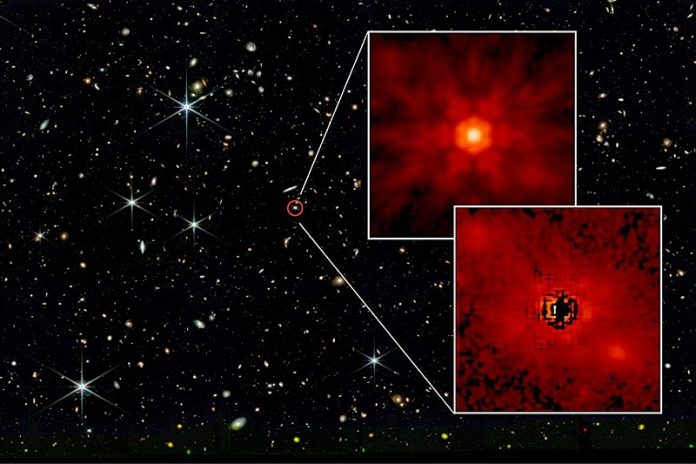
Supermassive black holes, like the one at the center of our Milky Way galaxy, take an incredibly long time to form.
Typically, a black hole is born when a massive star—at least 50 times the size of our Sun—burns out and its core collapses.
But this process can take up to a billion years, and even then, the resulting black hole is only about 10 times the mass of our Sun.
This is much smaller than the enormous black holes, such as the one in the Milky Way, which is about 4 million times the mass of our Sun, or the even larger black holes found in other galaxies that can be billions of times more massive.
These giant black holes grow from smaller ones by pulling in gas and stars, and by merging with other black holes, a process that takes billions of years.
However, the James Webb Space Telescope has recently discovered supermassive black holes that existed when the universe was still very young, much earlier than scientists thought possible.
Astrophysicists at UCLA believe they have found a surprising explanation: dark matter might have played a crucial role in the formation of these early supermassive black holes.
Dark matter is a mysterious substance that makes up most of the matter in the universe, but scientists still don’t know exactly what it is.
Normally, gravity pulls gas together to form stars and black holes. But in the early universe, gas clouds cooled too quickly, which prevented them from forming large black holes.
Instead, the gas broke up into smaller sections, forming many small stars and black holes rather than one giant black hole.
The cooling of gas is controlled by the amount of molecular hydrogen it contains. Molecular hydrogen acts as a cooling agent, absorbing heat and allowing gas clouds to cool down quickly. When gas cools, it loses pressure, which means gravity can pull it into smaller pieces, making it difficult to form large black holes.
To solve this puzzle, the UCLA researchers, led by Professor Alexander Kusenko, suggest that dark matter might have produced radiation that prevented the gas from cooling too quickly.
This radiation would break up molecular hydrogen, keeping the gas hot and allowing it to stay in large clouds. These large clouds could then collapse directly into supermassive black holes.
But where did this radiation come from? The scientists propose that dark matter might be made of particles that slowly decay, releasing radiation in the form of light particles called photons.
Even a tiny amount of this radiation could be enough to stop the gas from cooling too quickly, helping to form the supermassive black holes observed in the early universe.
This idea is exciting because it not only provides an explanation for the early formation of supermassive black holes, but it also offers a potential clue about the nature of dark matter. If dark matter did produce the radiation that kept the gas hot, it could be a key to understanding the mysterious dark sector of the universe.
In conclusion, dark matter might have played a critical role in the formation of supermassive black holes in the early universe by providing the radiation needed to keep gas clouds from cooling too quickly.
This theory could help solve one of the biggest mysteries in astrophysics and bring us closer to understanding the true nature of dark matter.
Source: UCLA.



